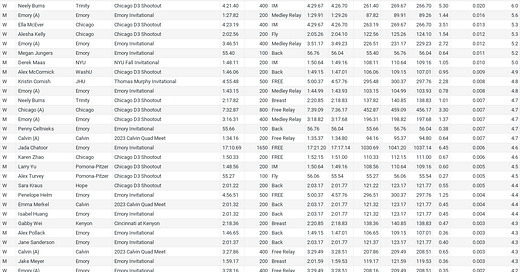Ranking the top swims in Division III so far
This should cover every B Cut so far. Explanation of table columns below. Hot take: We need to write a post on Neely Burns.
M/W: Men’s events/Women’s events
These are all self-explanatory
Athlete name
Athlete team
Meet
Time in event
Distance of event
Event stroke
The 2023-24 NCAA Division III Swimming and Diving Qualifying Times, B Cut Column.
ASP: Approved Selection Process time. For Women’s events that means the fastest time from the 20th fastest athlete in individual events, and the fastest time from the 20th fastest relay. For Men’s events that means the fastest time from the 16th fastest athlete, and the fastest time from the 16th fastest relay.1
Time LEN: Anyone here familiar with Python? Oh good, you should be employable for at least a couple more years, until your employer figures out how to type the correct prompt into an LLM to produce the Python code you’ve been working on for months. I am encouraging my children to become union plumbers. Let’s see LLMs do that work.
Where was I? Have you seen this?
=IFERROR((IFERROR(LEFT(B2,FIND(":",B2)-1)*60,0))+RIGHT(B2,LEN(B2)-FIND(":",B2)),VALUE(B2))It is a small bit of code you can drop into an Excel cell and it will break down a USA Swimming or SwimCloud reported time into a base of seconds and decimal of seconds, which allows you to do calculations on those times.
Yup, free of charge. Have at it.
Time LEN is simply the time posted by the athlete, broken down into a format of seconds, tenths and hundredths, so we can do something with it.
B Cut LEN: you’ve already got this figured out. Bunch of smart cookies. Usable format for B Cuts times.
ASP LEN: Do I even need to write this sentence?
DIFF: This is ASP LEN minus Time LEN. So, this measures how far the swim is from the standard established by the ASP.
DIFF Factor: This is where we really go deep into the middle-school mathematics. We divide the DIFF by the ASP LEN.
At D3SO, we are going to increasingly lean on ASP times, because they have a number of virtues that distinguish them from B-Cuts and posted ‘invite times.’ On ‘invite times’, don’t get us started. They do not mean what they appear to mean and no one wants to read more posts on how the invite time corresponds with times posted by athletes who did not actually get invited to Nationals, making the literal meaning of ‘invite times’ something approaching the opposite of the actual meaning of invite times. That, in the strict sense, is the definition of irony.
How the NCAA reports invite times in Division III swimming is broken, but we are not here to just dunk on the NCAA over and over again.
We came up with a better, not-ironic, and more reliable system and we are going to use it. An ASP time was a guaranteed invite time from the previous year. Let’s start there.
The phrase ‘guaranteed invite’ also points towards why we want to get away from B Cuts as a distinction for Nationals-focused athletes. If you get an invite, B Cuts are not relevant. They do not constrain your choice of which events to swim. For relay-only swimmers, B Cuts do open the door to participation in individual events. That matters, so we will not stop talking about B Cuts altogether. But we will lean more heavily on the ASPs, because those numbers are closer to telling Nationals-focused athletes what they want to know (as in, will I get an invite in this event given my current best time?).
As the season progresses, we will run the ASP times backward through 2011, then create a trend line and estimate the likely ASP times for the rest of the season. And then when we get to February it won’t matter anyway, because the ASP time will be obvious just by counting heads in each event.




